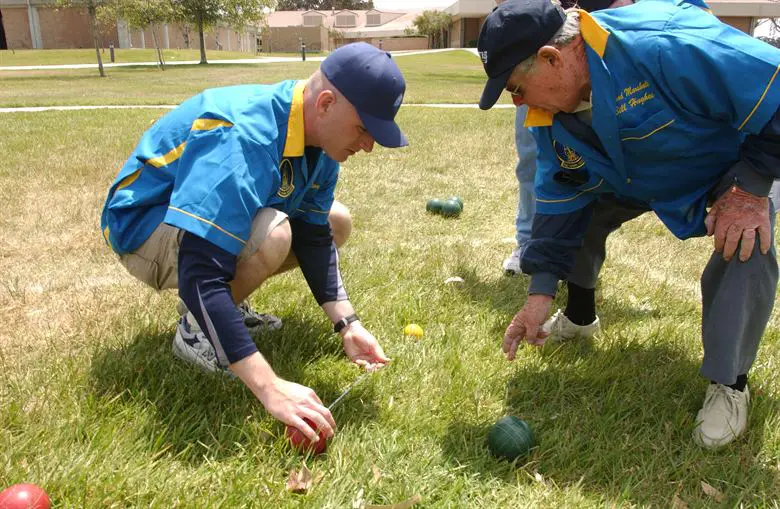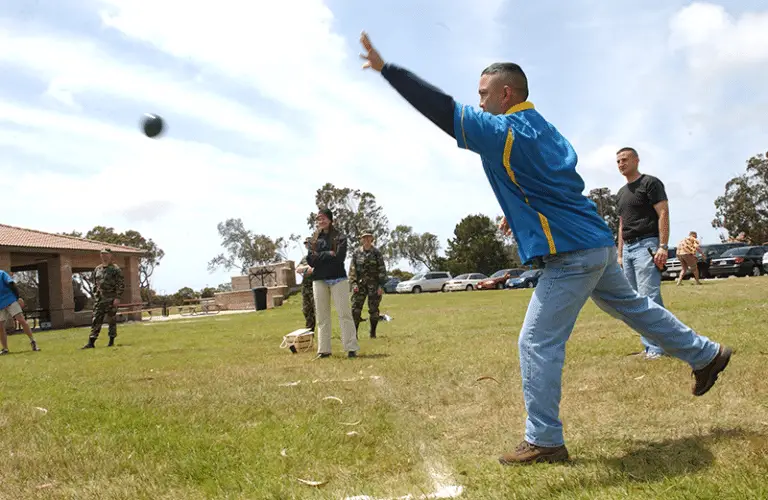Bocce ball is widely played in various countries across the world as it increasingly gains popularity.
It is also one of the oldest games, and there are quite a number of bocce variants.
As much as this game has been around for a long time, have you been playing it correctly?
Today, we will cover the basic rules of bocce ball especially for beginners playing it for the first time in their lives.
You’d be surprised how many people unknowingly make mistakes and break the rules when playing bocce.
Navigation Table
Bocce Ball Rules: The Basics For Complete Beginners
Bocce can be played in official leagues (check official rules (a bit complicated to understand for a beginner)), or it could be played casually in the backyard or at the park.
The game of bocce is rich in rules and traditions.
Most people play bocce casually, so the focus here shall be on the basic rules of the game.
- When playing in an open setup, then players do not have to stick to the official court dimensions of 90ft by 13ft. Whichever space is available could work. Just make sure you get the proportions as accurately as possible and mark off the five lines. The five lines are two lines drawn 4-ft from either end of the court, two lines drawn 10-ft from either end of the court (foul lines), and a centerline down the middle of the court (half-court marker).
- Players should toss while standing behind the 10-ft line on one side of the court. With each frame, the players should alternate the side of the court they are throwing from.
- When playing in teams having multiple players, the playing rotation is determined at the beginning of the game. The players then have to stick to this throwing order throughout the game.
- Each frame starts with the toss of the pallino. If the first player/team makes two attempts at throwing the pallino and fails to get it past the centerline or throws it outside the bounds of the court, then they forfeit the chance to the opponent.
- The player who tosses the pallino should be the same player that throws the first ball.
- When playing bocce, the objective of the game is to get your balls closer to the pallino than your opponent’s balls are.
- In a bid to do so, it is allowed to knock an opponent’s ball out of play. You may even knock the pallino further from an opponent’s ball and move it closer to your own balls. No bonus or penalty is awarded in such an instance. However, you cannot knock the pallino back over the centerline. If the pallino gets knocked out of the court, then that frame ends.
- If playing on a court with sidewalls, it is allowed to bounce the ball off the sideboards. However, a bocce ball should first touch the pallino or other bocce balls before hitting the backboard. Failure to do so, this shall be considered a dead ball and effectively removed from play.
- If a player happens to throw the wrong color ball, then first let the ball come to rest on the play area then replace it with the correct color ball.
How to Play Bocce Ball

A bocce ball set comes with eight playing balls in various colors and a pallino. The game can, therefore, be played by 2, 4, or 8 players either individually or in two teams.
To identify which bocce balls, belong to which player, use the color-coding or use the patterns on balls having similar colors.
Each game of bocce consists of frames/ends/rounds whereby the eight balls are distributed evenly among the players present. So, if you are playing in teams, then each side will have four balls per frame.
The first frame of the game starts with a coin toss. The winner of this coin toss gets to toss the pallino, ensuring it crosses the centerline. For consequent frames, however, the pallino is thrown by a member of the team, which won the previous frame.
The player (player 1) that throws the pallino also gets to throw the first bocce ball.
If you have a good aim, the strategy should be to stop your bocce ball just in front of the pallino.
Once the first ball has been tossed, the play then goes to the opposing team/player (player 2). The opponent should try to get their ball closer to the pallino than that of player 1.
If Player 2 succeeds in getting their ball closer, then this ball is considered ‘inside.’ If they fail to do so, they will keep throwing each of their remaining balls until one ball is ‘inside.’
Once player 2 gets a ball ‘inside,’ then the play switches back to player 1 who also attempts to get a ball ‘inside.’ This process continues until all eight balls have been thrown.
Once this is done, the player/team with their ball closest to the pallino wins that frame. Scores are tallied, and that frame is considered complete.
The winning player/team then gets to toss the pallino in the next frame.
Bocce Ball Scoring: How Do You Do It?
In each frame, only one team can score. This is because only the team/player whose ball is closest to the pallino gets the respective points.
If during play, the pallino gets knocked outside the bounds of the court, then that frame ends, and no points are awarded to either team. A new frame starts.
One point is awarded for each ball that is closer to the pallino than the opponent’s closest ball.
A ball that touches the pallino is worth 2 points. This ball is referred to as a ‘kiss’ or ‘baci.’ The two points are only awarded if the two balls remain touching by the end of the frame.
If a player’s ball and an opponent’s ball are both equidistant from the pallino, then no points are awarded to either player. There would be no winner in such a frame, and so the pallino tossing privilege goes back to the team that tossed it in that frame.
All measurements are made for the middle of the pallino to the edge of the bocce playing balls.
The winning team will always score a minimum of one point and a maximum of four points, assuming all their balls land closest to the jack or that they have a kissing ball.
Games are played to a pre-determined number of points. This typically ranges from 11 points to 21 points. The exact value depends on the region where the game is being played. It also depends on what the players might have agreed on at the beginning of the game.
12 points often work well for casual backyard bocce ball games.
The team which first scores the 12 points wins the game, and players can then start another round.
More players mean lower scores, so you might consider reducing the points to shorten the game and keep it exciting.
How to Throw A Bocce Ball The Right Way
When playing official bocce, the ball should always be thrown underhanded. This is done while the player is standing behind the 10-ft line. An underhand throw best delivers a combination of control and power.
For informal bocce, players are allowed to use both overhand and underhand throws.
Using an underhand throw, the player may choose to roll the ball, toss it, bounce it, make a bank shot, or pretty much just anything else.
Game strategies include blocking, bumping, and banking. Blocking involves setting up a perimeter of your own balls around the pallino to prevent your opponent from getting ‘inside.
Banking is when a ball bounces off the sidewalls of the playing court. This is done to move it as close to the pallino as possible. Bumping is when the player manipulates the jack with their throw.
Making a long and hard throw to loft the ball in the air beyond the centerline is known as Volo shooting, and this is not allowed.
This throw is made to spock the opponent’s balls, but it can cause harm by breaking the bocce balls, damaging the playing surface or potentially injuring other players.
Bocce Ball Strategies
Winning at bocce requires a lot of strategies when throwing the ball. You need to know when to aim for an opponent’s ball and when to aim for the pallino.
You may knock an opponent’s ball further from the pallino, or you may push the pallino closer to your own balls.
Sure, the game requires physical strength to throw the ball but simply throwing the ball as hard as you can is not enough. A lot more brainpower is needed when playing bocce.
Before making a throw, the player has to consider factors such as velocity and distance.
Not to mention that winning in bocce demands a high level of hand-eye coordination.
This is because the player ought to release the ball just at the right moment and using the appropriate underhand throw technique to achieve their desired result.
Where to Play Bocce Ball
Traditionally, bocce should be played on a court that measures 90ft in length and 13ft in width. The court surface was made of natural soil or asphalt.
With the evolution of the game, however, bocce is now played on a variety of surfaces such as grass lawns, artificial turf, beach sand, compacted dirt, clay, stone pavements, gravel surfaces, patios, wooden decks, etc.
The only requirement is that the playing surface is flat and relatively smooth.
Although you do not need to stick to the official court dimensions when playing bocce causally, playing on a larger area makes the game more challenging and more exciting as well.
In some cases, the players could choose to play extreme bocce whereby the playing surface is irregular by being hilly, containing mixed materials, or having natural obstacles.
This makes the game more challenging, and it is allowed as long as all players agree to it.
Conclusion: What Now?
Bocce is a relatively simple game, and the bocce ball rules are rather straightforward.
Nevertheless, understanding the rules will help you enjoy the game much better.
Who knows, being familiar with the rules could even improve your game, therefore helping you score higher points.
Now, it is time to throw some balls. Enjoy.

